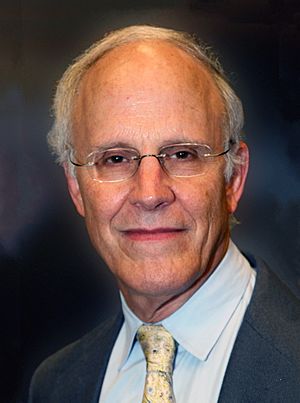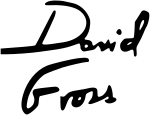David Gross facts for kids
Quick facts for kids
David Gross
|
|
|---|---|

Gross in 2007
|
|
| Born |
David Jonathan Gross
February 19, 1941 Washington, D.C., U.S.
|
| Education | Hebrew University of Jerusalem (BSc, MSc) University of California, Berkeley (PhD) |
| Known for | Asymptotic freedom Het... string Gross–Neveu model |
| Spouse(s) | Shulamith Toaff Gross (divorced) Jacquelyn Savani |
| Children | 2 |
| Awards | Dirac Medal (1988) Harvey Prize (2000) Nobel Prize in Physics (2004) |
| Scientific career | |
| Fields | Theoretical physics |
| Institutions | University of California, Santa Barbara Harvard University Princeton University |
| Thesis | Investigation of the many-body, multichannel partial-wave scattering amplitude (1966) |
| Doctoral advisor | Geoffrey Chew |
| Doctoral students | Natan Andrei Frank Wilczek Edward Witten William E. Caswell Eric D'Hoker Rajesh Gopakumar Nikita Nekrasov Stephen Bernard Libby |
| Signature | |
 |
|
David Jonathan Gross (/ɡroʊs/; born February 19, 1941) is an American theoretical physicist and string theorist. Along with Frank Wilczek and David Politzer, he was awarded the 2004 Nobel Prize in Physics for their discovery of asymptotic freedom. Gross is the Chancellor's Chair Professor of Theoretical Physics at the Kavli Institute for Theoretical Physics (KITP) of the University of California, Santa Barbara (UCSB), and was formerly the KITP director and holder of their Frederick W. Gluck Chair in Theoretical Physics. He is also a faculty member in the UCSB Physics Department and is affiliated with the Institute for Quantum Studies at Chapman University in California. He is a foreign member of the Chinese Academy of Sciences.
Contents
Early life and education
Gross was born to a Jewish family in Washington, D.C., in February 1941. His parents were Nora (Faine) and Bertram Myron Gross (1912–1997). Gross received his bachelor's degree from the Hebrew University of Jerusalem, Israel, in 1962. He received his Ph.D. in physics from the University of California, Berkeley in 1966, under the supervision of Geoffrey Chew.
Research and career
In 1973, Gross, working with his first graduate student, Frank Wilczek, at Princeton University, discovered asymptotic freedom—the primary feature of non-Abelian gauge theories—which led Gross and Wilczek to the formulation of quantum chromodynamics (QCD), the theory of the strong nuclear force. Asymptotic freedom is a phenomenon where the nuclear force weakens at short distances, which explains why experiments at very high energy can be understood as if nuclear particles are made of non-interacting quarks. Therefore, the closer quarks are to each other, the less the strong interaction (or color charge) is between them; when quarks are in extreme proximity, the nuclear force between them is so weak that they behave almost as free particles. The flip side of asymptotic freedom is that the force between quarks grows stronger as one tries to separate them. This is the reason why the nucleus of an atom can never be broken into its quark constituents.
QCD completed the Standard Model, which details the three basic forces of particle physics—the electromagnetic force, the weak force, and the strong force. Gross was awarded the 2004 Nobel Prize in Physics, with Politzer and Wilczek, for this discovery.
..... The four were whimsically nicknamed the "Princeton String Quartet." He continues to do research in this field at the KITP.
He was a junior fellow at Harvard University (1966–69) and a Eugene Higgins Professor of Physics at Princeton University until 1997, when he began serving as Princeton's Thomas Jones Professor of Mathematical Physics Emeritus. He has received many honors, including a MacArthur Foundation Fellowship in 1987 and the Dirac Medal in 1988.
Activism
In 2003, Gross was one of 22 Nobel Laureates who signed the Humanist Manifesto.
Gross is one of the 20 American recipients of the Nobel Prize in Physics to sign a letter addressed to President George W. Bush in May 2008, urging him to "reverse the damage done to basic science research in the Fiscal Year 2008 Omnibus Appropriations Bill" by requesting additional emergency funding for the Department of Energy's Office of Science, the National Science Foundation, and the National Institute of Standards and Technology.
In 2015, Gross signed the Mainau Declaration 2015 on Climate Change on the final day of the 65th Lindau Nobel Laureate Meeting. The declaration was signed by a total of 76 Nobel Laureates and handed to then-President of the French Republic, François Hollande, as part of the successful COP21 climate summit in Paris.
Family
Gross' first wife was Shulamith (Toaff), and they had two children. He also has a stepdaughter by his second wife, Jacquelyn Savani. He has three brothers, including Larry Gross, professor of communication, Samuel R. Gross, professor of law, and Theodore (Teddy) Gross, a playwright.
Honors and awards
- J. J. Sakurai Prize, American Physical Society (1986)
- Fellowship Prize, MacArthur Foundation (1987)
- Dirac Medal, International Center for Theoretical Physics (1988)
- Oscar Klein Medal, Royal Swedish Academy (2000)
- Harvey Prize, Technion-Israel Institute of Technology (2000)
- High Energy and Particle Physics Prize, European Physical Society (2003)
- Grande Médaille d'Or, French Academy of Sciences (2004)
- Nobel Prize in Physics (2004)
- Golden Plate Award, Academy of Achievement (2005)
- San Carlos Borromeo Award, University of San Carlos, Philippines (2008)
- Honorary Doctorate in Science, the University of Cambodia (2010)
- Richard E. Prange Prize, University of Maryland (2013)
- Medal of Honor, Joint Institute for Nuclear Research, Dubna, Russia (2016)
Memberships in academies and societies
- NSF Graduate Research Fellowship Program, National Science Foundation (1963–66)
- Fellowship, Alfred P. Sloan Foundation (1970–74)
- Fellow, American Physical Society (elected 1974)
- Member, American Academy of Arts and Sciences (elected 1985)
- Member, National Academy of Sciences (elected 1986)
- Fellow, American Association for the Advancement of Science (elected 1987)
- Honorary Fellow, Tata Institute of Fundamental Research (2005)
- Member, American Philosophical Society (elected 2007)
- Honorary Fellow, Indian Academy of Sciences, Bangalore, India (elected 2007)
- Fellow, The World Academy of Sciences for the developing world (elected 2007)
- Member, International Academy of Philosophy of Science (elected 2009)
- Foreign Member, Chinese Academy of Sciences (elected 2011)
- Foreign Member, Russian Academy of Sciences (elected 2016)
- Elected to a four-year term in the presidential line, the American Physical Society (2016–2020)
Selected publications
Journal articles
- D. J. Gross and F. Wilczek, "Asymptotically Free Gauge Theories. I", Phys. Rev. D8 3633 (1973)
Technical reports
- Wilczek, F. and D. J. Gross. "Asymptotically Free Gauge Theories. I," National Accelerator Laboratory, Princeton University, United States Department of Energy (through predecessor agency the Atomic Energy Commission), (July 1973).
- Gross, D. J. and S. B. Treiman. "Hadronic Form Factors in Asymptotically Free Field Theories," Princeton University, United States Department of Energy (through predecessor agency the Atomic Energy Commission), (1974).
- Callan, C. G. Jr., Dashen, R. and D. J. Gross. "Instantons and Massless Fermions in Two Dimensions," Princeton University, United States Department of Energy (through predecessor agency the Energy Research and Development Administration), (May 1977).
- Gross, D. J. "Some New/Old Approaches to QCD," Lawrence Berkeley Laboratory, United States Department of Energy, National Science Foundation, (November 1992).
See also
 In Spanish: David Gross para niños
In Spanish: David Gross para niños
- List of Jewish Nobel laureates

